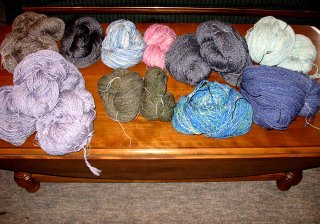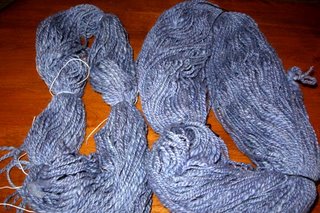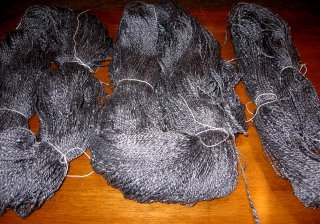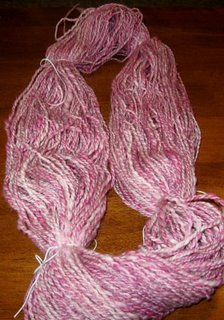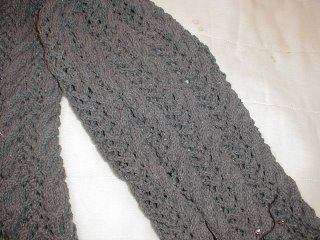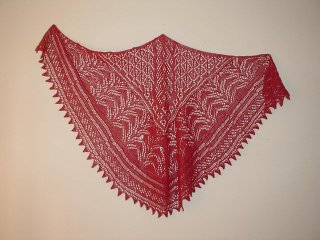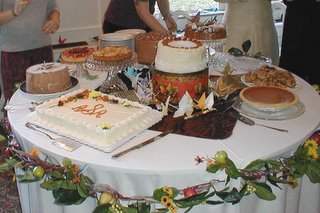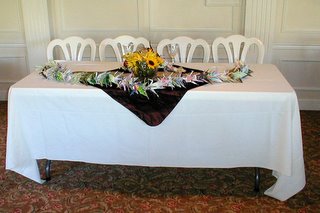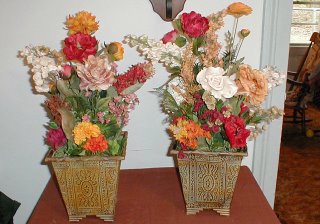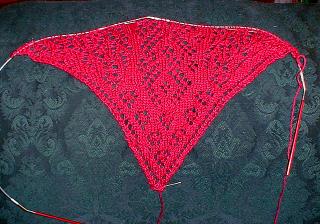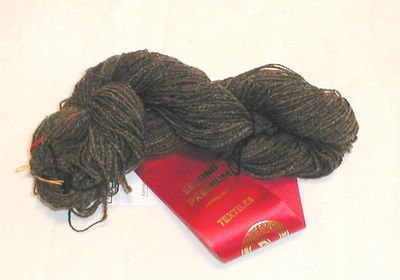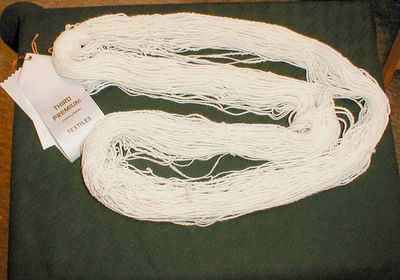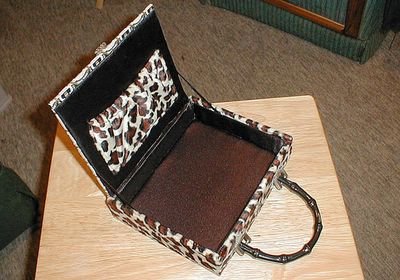I do not think I would knit if there was no challenge to it. That's why there are no afghans of endless garter stitch coming off my needles. I have reached the point in my knitting skills where I need the challenge to keep me knitting long enough to finish the project.
Sometimes the challenge comes from the fact I am creating the design myself. Sometimes the challenge is learning a complicated stitch. Lately the challenge has come from knitting two very complicated garments in two separate online knit alongs. I thought it be a good update to this blog to talk about them, both well under way, but far from finished. I have learned so much already, and have a problem to solve on one of them.
First thing I have learned is that it is a good thing to have two completely different type of knitting projects going at the same time. It allows me to detach from the frustrations of one, even if I find frustrations in the other! My two projects, the FLAK sweater and a lace knitted mystery shawl are as different as they can be. The lace shawl is on circular needles, and is following a very detailed chart. It does have the advantage, at least where I am right now of having a knit row between the pattern rows. This becomes very essential for counting stitches in the repeats, as I am much to busy trying to follow the chart when doing the pattern row, to try and count stitches also.
Both projects seem to have the limit of doing a few rows at a time. This is not because I have limited knitting time, it is because the patterned rows go so slow, and the number of stitches are so great, that it takes me a long time to complete each row. So my progress on each is slow, and slowed even more as I bounce back and forth between the two. I have no set goal for their completion. Most of the knitters in both of the knit along groups have completed theirs. I thought the knit alongs would make me feel pushed as far as knitting to keep up with the vast majority of the group, but I found I join the knit alongs more to read about the others progress and to pick up hints and tips as they experience the patterns for the first time. It has often helped in the long run to let the others find the problems and then just sail through that difficult patch, with their experience.
With the above generalization in mind, here are a few specifics I have learned on each project.
The mystery shawl is only to row 52. This was a start in the center in a circular start and increase outward from there. It will eventually be a square, which sounds weird, considering the circular start. The increases are making four pie shaped pieces, joined at the center, with an eventual shaping to a square. Some of the knitters are only doing half, making a triangle shaped shawl. That's an option I may consider down the road, if I do this pattern again. Each pie shaped piece repeats the same pattern, so on my needles I have the areas divided by stitch markers. Each repeat currently has 64 stitches so at only row 52 I have 256 stitches. This is why it takes me awhile to get through the knitting of a pattern row. And that will only get longer as I knit on. What have I learned? That I probably would like casting on a thousand stitches and decreasing, instead of casting on 8 and increasing to a 1000!
One of the major things to watch in the pattern is that the designer has put a YO as the first stitch of the design block. That means a YO falls just after one of my stitch markers. It took me almost the first 43 rows of never hitting the pattern right (that is, I would count the stitches on the knit row and be off a stitch here and there) to realize I really really had to watch those YO. They almost always flop over the stitch marker, ending up as the last stitch of the section, instead of the first of the next section. And when some would flip, and some wouldn't, I was off on my stitch count again and again.
Now I am not a perfectionist knitter. In fact, I would say that is one of my biggest flaws as a knitter, I have too much of a Oh never mind, attitude about it all. So those first 43 rows will definately show that I was not in line on the patterning. I am not concerned though for a number of reasons. This shawl is for me, those first 43 rows will be a tiny center of a large shawl, the shawl will most likely be folded in a triangle to wear, and well, all in all, this is all about loving and learning the knitting, not unknitting. So now that I have figured out that watching those YO's and getting them in the right place is my primary concern on the non patterned knit row, I have had very little problem with the stitch count, and my patterning is working out fine.
I do not have a picture of this yet, it is only just a puddle of lacy knitting between the circular needle. It may stay that way too until I am done, so when I post a picture of the final shawl, I will probably be just as surprised at it's appearance, as anyone reading this. The yarn is a lace weight, Cherry tree merino in muted colors against a brown. It's just lovely to work with the subtle blends of the coloration is fascinating to me, when I do finally look at the shawl, beyond the chart following and counting.
Now for the FLAK sweater. That's follow the leader aran knitalong for anyone unfamiliar with the term. What have I learned? Oh a lesson so big, it deserves capital letters.
IF YOU ARE GOING TO KNIT A SWEATER FOR SOMEONE OTHER THAN YOURSELF, MEASURE THEIR BODY, NOT ONE OF THEIR SWEATERS.
See, I have plans to knit this sweater for my hubby, and surprise him with it. It was no big deal to knit in front of him, he had no clue I was knitting it for anyone else but myself. The knit along was all set up to be about knitting a sweater that fit, because the designer Janet Szabo gave wonderful sections on measuring and swatching and calculating for a perfect fit. I was the unknown factor in this process, because in my attempt to surprise my hubby, I used the alternative suggestion of measuring a sweater that fit instead of the body (stated as a possibility if one could not really do the measurements by themselves, on themselves.) So I grabbed a bulky sweater that hubby had on the cedar chest at the foot of the bed, measured it and proceeded with those measurements. Never mind I had never seen the actual sweater on hubby. So maybe the other capital letter learning should be, never assume that just because a sweater is out and in full view, that spouses actual can wear them.
Yep, you saw it coming. Said sweater is too small. So now my FLAK sweater for hubby is too small. I found this out, after knitting one full sleeve and a third of the other. Based on the experience of the last sweater I did for my daughter, and the sleeves ending up too large, I finally broke down several weekends ago and had hubby try on the FLAK. That's when it was discovered that the sweater could use 1-2 inches of ease around the body, and that the armhole depth is much too tight, it needs 2 inches at least also.
Here's a picture of how it looks so far:

See how it basically is long long rectangle including the sleeves. The next step after the sleeves are finished would be to sew up the sleeves (some knitters are even doing the sleeves in the round, but I like the straight needles) and pick up stitches all the way around the body in the round and knit to the bottom. So in my thinking about the sweater being too small I feel it is possible to add to the sweater yet at this point, before that final step. I have lots of time to think about this fix, as I knit the endless moss stitch of the sleeves (which, surprising I like doing better than endless garter or stockinette stitch even though it does mean switching from a knit to purl with every stitch). In fact this stretch of mindless knitting has been fun, because it allowed me also to watch a whole season of Battlestar galactica, while knitting. But I also have been mulling over possible ways to make this sweater eventually fit.
Here's the plan at this point: Since the armhole depth is based on stitches picked up at the front and back edges, that means I need more stitches there to use to pick up and add to the sleeve. See how the sleeves and the front are the same right now? I plan to knit an inch more down both sides of the front and back. That will give me a total of two inches next to the sleeve. If I tied my yarn on right next to the sleeve edge and one of those stitches, I can pick up the first inch, go to the other side of the sleeve, and pick up an inch from those stitches. This two inches will be knit in the moss stitch, as I go down the sleeve catching each sleeve edge and closing the sleeve with knitting instead of seaming the sleeve. The other option is to pick up the inch of stitches and knit those separately, and then seam the sleeve. I will decide which looks better, after I actually get into the process. I think this will solve the problem of the too tight sleeve, without actually frogging miles of moss stitch and starting over.
It may or may not solve the ease needed around the body. But I do not consider this a major problem, because right now, with just putting the sweater over hubby, with all of the unfinished seams etc, I am not really sure the fit is all that far off. And once I get the sleeves closed and have him try it on, I will be able to tell if the body needs ease or not. If it does, I will increase stitches as I pick up the body and add the ease at that point.
Lesson learned. Challenge thought about but not accomplished. It will be interesting to see just what happens and how the final product looks. I am less concerned about appearance though, than comfort. I truly want him to wear the sweater, I feel that way about anything I make. That's why I am not a perfectionist knitter. It is not about how it looks, just about how it feels.
So no finished projects to report, just progress. In the same way, my spinning is still in progress too. Remember the Olympic challenge to spin while watching the olympics? Well here is an 'in progress' picture. With the wonders of DVR dish recording I still have 20 hours of olympics to watch. And to me that means another 20 hours of spinning time. So it will be awhile before the final photo of all the yarn. Meanwhile, here's a picture of my spinning world, my easy chair, my Roberta electric spinner, my yarn on the niddy noddy. I suppose I should have included the cup of coffee (I always do my spinning in the mornings before work) and the TV remote too!
CW

